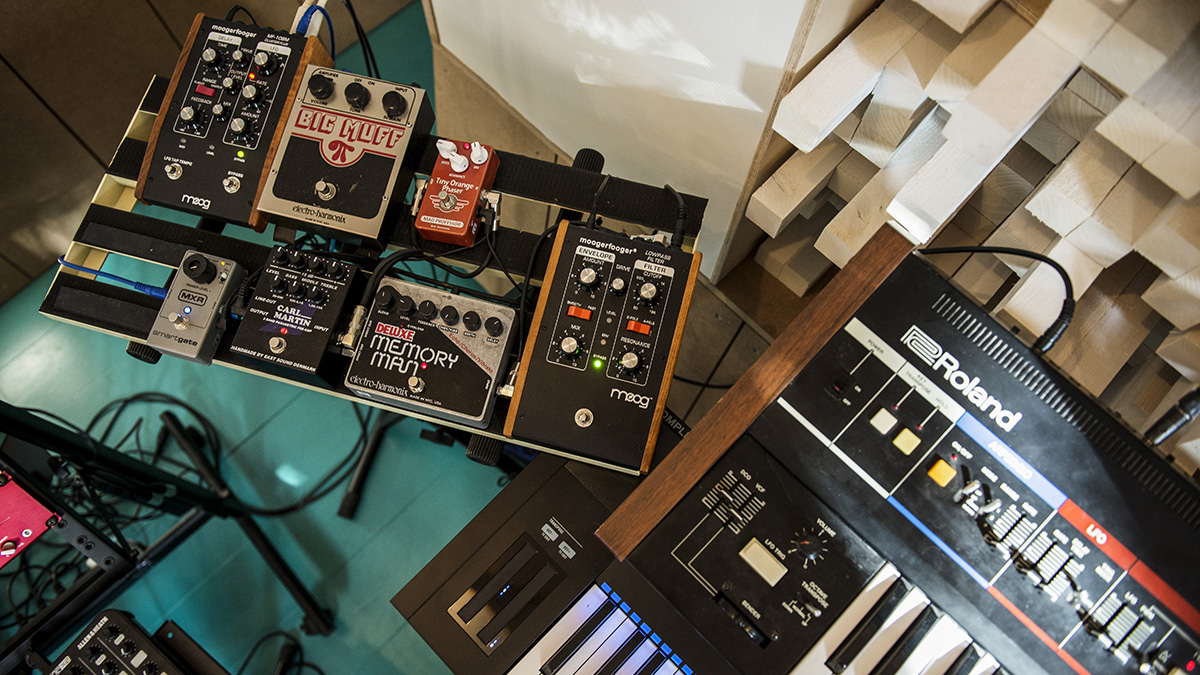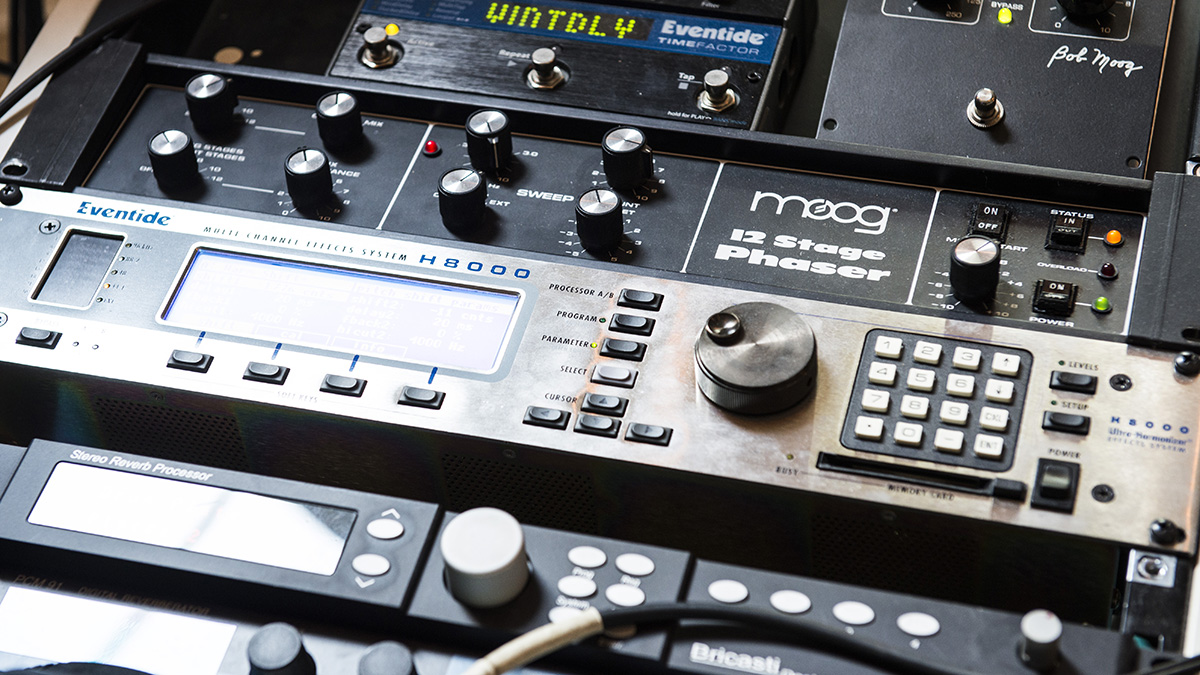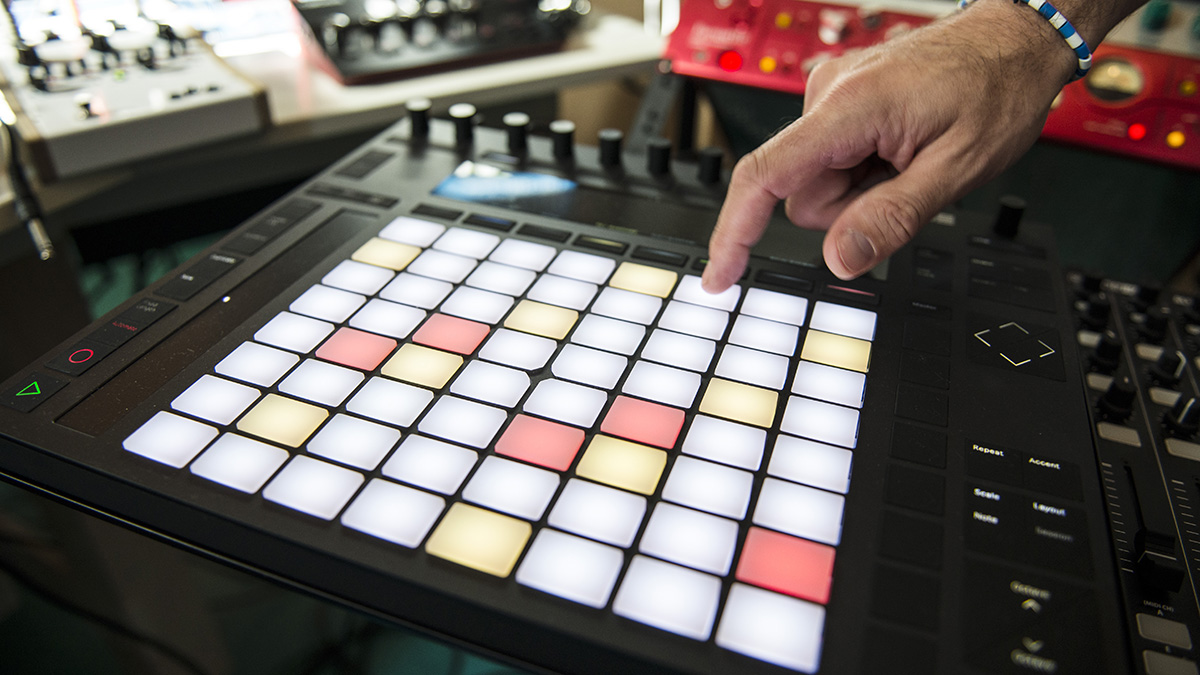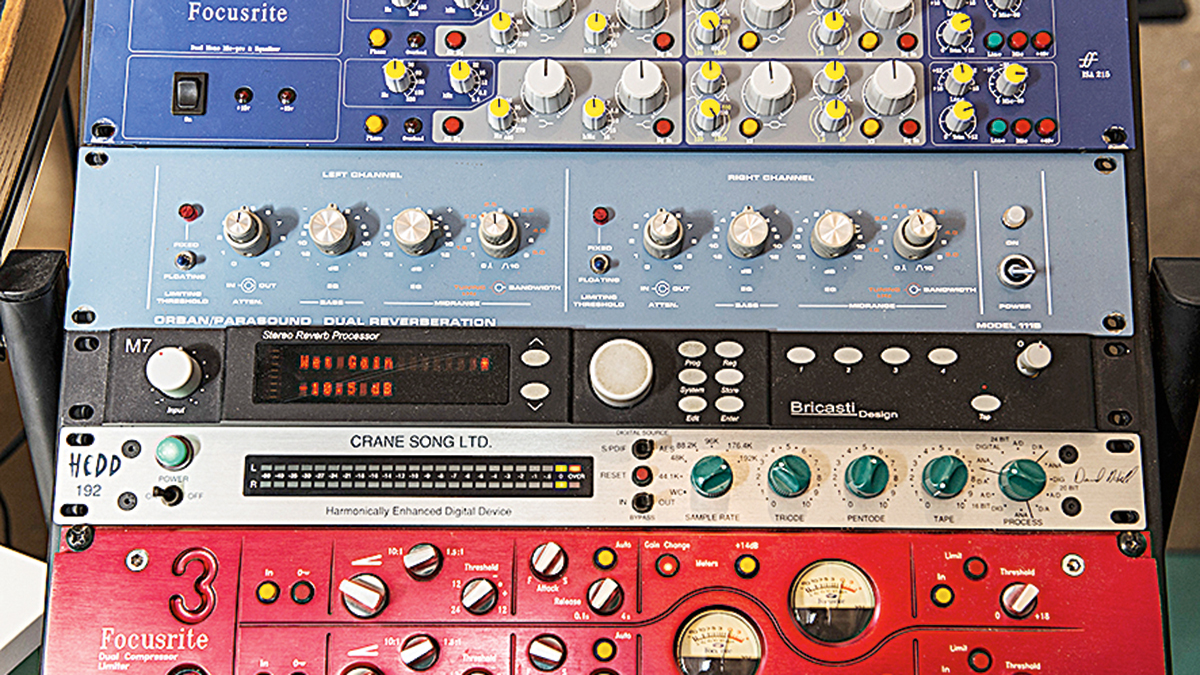Sebastian Mullaert: "I feel that my music is more alive and organic, and maybe that’s what makes everything sound true to the classic techno sound"
Revered techno producer talks to us about his creative approach to music production and his new EP Samunnati

Scandinavian producer Sebastian Mullaert made his name alongside Marcus Henriksson as one half of the groups Minilogue and Son Kite. More recently, however, Mullaert has focused on his solo career, releasing the EP Samunnati, based on a fan remix sent to him by bedroom producer Daniel[i].
The genesis of the track came from a melody recorded live on Mullaert’s Roland SH-101, one of many analogue synthesizers adorning his stunning studio, set in the remote woodlands of rural Sweden.
Having built his studio virtually from scratch, and surrounded by the lush forestry of a national park, Mullaert is rarely lost for inspiration. Following a meditative walk, his daily working process begins with the evolution of multiple organic loops and mantras, sparked from Mullaert’s studio ‘cockpit’, where the producer favours a performance-based approach using classic vintage gear, analogue pedals and effects chains.
Is Sebastian Mullaert the solo artist a new direction for you, or just a temporary diversion?
“We all change, move on and do different things, but I like to think there’s always an evolution. Having a solo career actually allows me to collaborate more, because it enables me to work with different people. They’re two completely different creative approaches.
"When you’re on your own, it becomes a more meditative experience where you’re tuning in to yourself and expressing something very personal. When expressing music with other people, it becomes more of a dialogue – a process of tuning in and finding a flow.”
Is it refreshing to have full creative control over the music you’re making at present?
Want all the hottest music and gear news, reviews, deals, features and more, direct to your inbox? Sign up here.
“Right now, I really enjoy this situation. I’m building up my studio, which I see as my own little island or forest, where people can come and express themselves with me. My long-term vision is to make the studio open and accessible to a wide range of musical and creative people – modern composers, acoustic instrumentalists or other electronic artists. I want to create a space where people can connect with their creativity, both through the surrounding nature and the studio itself.”

We understand the idea behind Samunnati was inspired by a 12-minute fan remix…
“Yes, exactly – I like the idea of acknowledging other people. In this world there are many efficient structures that create a formula for everything: how to run a magazine, how to do an interview, write a track or handle a DJ career. These tendencies exist and there’s nothing wrong with them, but if that’s all there is, then I feel the creativity and passion behind the music can get lost.
"I think it’s very important to inspire and help each other to find our own way, and I really like the way that Daniel[i] sent me versions of my own tracks. Maybe some people would see it as a bit strange that we would actually release them together, but I welcomed it. For him it was like, wow, I did nothing wrong in trying to express myself this way because another artist took the invitation further.”
The record has a very classic techno sound. How much of that is that driven by the technology you’re using as opposed to its compositional arrangement?
“Sometimes I have a hard time comparing my music with others. Like you say, the technology behind the music always filters the sound. As much as what synthesizers and chords you use, the way that you tweak the EQ, how much noise you have in your cables or the techniques you use when compressing also add a specific sound.
"I see myself as being very connected with the studio I work in; we are really teammates. I can do a lot of different things with the gear that sits in here, but at the same time there are certain limitations that add a signature to my sound. I like to use a lot of outboard gear, from Eventide harmonizers to lots of old hardware like phasers, compressors and EQs. They’re all a little bit noisy, but sound very alive. When you compare them to a lot of computer-made music, I feel that my music is more alive and organic, and maybe that’s what makes everything sound true to what you called the ‘classic’ techno sound.”

How does your individual technique bleed into that process?
“My studio technique really shapes my sound. I use my fingers a lot – both to play instruments and tweak the knobs, but also to create patterns and mantras with the faders on the mixing desk. I believe almost everything is based on patterns: melodies, rhythms, frequencies, even the invention of different instruments and how to play them.
"When I make music, it’s almost as if I have a piece of clay in front of me and the sound becomes like a mantra where I’m adding melodies, pushing noise through the compressors and adding little rhythms until everything starts to come together. I’ll record and mix specific elements, then take it apart, loop certain things and start the process again. It’s almost like a process of building soundscapes, where I’m merging different sounds together and then letting it fall apart until it all dances or breathes as one.”
And all of these separate takes are the building blocks for the creation of a complete track?
“I have quite a long preparation phase, where I’m creating this ‘sound stage’ of patterns. Although I guess it’s really a composing phase too, because it’s really creative and a lot of things are happening. It leads up to a point where I have loads of different leads and sounds on different channels on my desk and I’m ready to improvise a song. Then I’ll record takes based on those structures, shapes and soundscapes, and the second phase becomes more about live improvisation.”
How does your classical training filter into your everyday working practices?
“My father loved electronic instruments and used to listen to Tangerine Dream and Pink Floyd. I started playing synths like the Roland TR-808 and Juno-60, and we had a big Yamaha electronic organ with two keyboards and bass pedals. So from a very early age I started to jam around with that, then when I was eight I started to take lessons in the electronic organ. We also have a government-run music school in Sweden that enables anyone to get trained in using different instruments from an early age without much cost. It’s very typical of the Swedish mentality.”
I feel that my music is more alive and organic, and maybe that’s what makes everything sound true to what you called the ‘classic’ techno sound.
Is the idea behind the school to create future recording artists?
“The intention is not to create superstar instrumentalists, but to enable a wide range of people to give creative expression to their lives. In my youth, I was playing in string quartets with orchestras and classical ensembles, but a big turning point came when I was 17 and joined a band with my violin. I had a microphone and lots of effects pedals and really got quite hooked on writing my own music. I became less focused on my classical training, and around the same time started going to my first techno parties.
"This whole music, with its very new and fresh soundscapes, really captured me, so I started to experiment with a synthesizer, sampler, violin, and a lot of delays and effects. The last 20 years has been a continual expression of musical composition, slowly getting deeper into production, frequencies and sound.”

Why did you choose to build a studio in the remote woodland region of Röstånga?
“I grew up in an even more remote area – without any neighbours and away from the city on a farm. I lived with my wife in the city, first in Lund, which was a university city, and then we moved to Malmo for many years. In 2009, we moved out to this little village, which is a one-hour drive from Malmo. Some of our friends had already moved here and it is a very spiritual and culturally engaged place. My wife and I run a small hotel about 200 metres from my studio and it’s all directly connected to the national park. We also have a flat in the hotel. It’s a great place for someone to relax, connect with their creativity and work and collaborate in the studio.”
What were the challenges in building a fully functional studio out here?
“I found this ‘house’ for sale, but it hadn’t been used for many years. It was more like a little camping hut, with a lot of mould and mice. You couldn’t really live there. I kept the fundamental structure and built a new house together with a carpenter. It took six months and we rebuilt everything: water, toilets, heating and windows. The walls are 40cm thick, with insulation to soundproof the noise from outside and make sure what I do doesn’t go out.”
You had some problems initially…
“The problem was that the structure of the house is basically a big roof shape, almost like an A, and I was so focused on building the house that I wasn’t thinking about the acoustics. The shape is not good; you should never have a roof that is pointing like an A and coming together because it creates a bass horn. When the bass went up to the roof, it came down again, which is basically how a horn works – a wide angle that comes down to something thin.
"I had extreme bass cancellation right under the roof just above where I’m sitting and it was almost impossible to get right, so I contacted a very good acoustic engineer called Cleas Ohlsson who measured and defined how to rebuild the roof so that it’s angled slightly to the front but flat. On the sides, to the back and in front of me I have lots of bass traps, which make it sound really good. It’s been a long journey to get the sound right, but during this journey I got a much better understanding of sound and frequencies.”
Did you have a plan for how you wanted the studio to be constructed, so everything could be functional and integrated?
“It’s an ongoing evolution, but I really try to have everything within hands reach, like a cockpit. Everything from the mixer, which I really use a lot, to working with my fingers on the faders and EQs to form the sound patterns organically, reaching the compressors, the different keyboards, controllers, drum machines and the Rhodes. I can basically stand in the middle and reach something from every direction.”
Do you think it’s best to set limitations on the amount of outboard gear you use?
“Normally, unless you’re extremely rich and have a super-studio, there are limitations on how much gear you have. You may say, OK, I have these three outboard reverbs and have to use them on the whole mix, but that limitation also helps everything to glue together. I think if you’re doing everything in the box and using too many different plugins, reverbs and EQs, you start to separate everything, which means they don’t always glue together and you get a very crispy and cool mix that’s hard to connect with because it sounds so surreal – it’s not human anymore.”
What role does software play in your production process?
“When it comes to plugins, I’m not using them much. I may use some UAD plugins for final tweaking on the bass frequencies or a bit more compression here or there, but most of them are just simulations of outboard gear, so my use of plugins is more functional than creative. My hard disk recording system is what I record everything into. I have Pro Tools operating in the background, but really love the creative possibilities of Ableton.
"For recording very quickly on-the-fly, Ableton allows me to loop different parts of different recordings. For example, I’ll record a long improvised pad session with the Juno-60 and loop it from the end of a delay tail, take it out again from the mixer, change the EQ with distortion and compression and play on top of it again. The flexibility of Ableton means it’s made for that kind of jamming.
"I also have a loop pedal, which I use in the studio and when I play live. It’s always connected to my desk and I have it on a group, so I can send any sound from the desk and record small loops and then start to play on top of them. It just gives me the possibility to play on-the-fly, and with Ableton I can find different bars or phrases within that.”

And you use the Ableton Push controller too?
“I’ve started using that a lot more this year, but I‘m not just using the hardware sounds. I also have the Native Instruments Komplete package, so when I feel like there are certain sounds I don’t have, whether it’s a sample or a bass sound, I’ll open the software, scan through and play either from the keyboard or Push. I also have a little Allen & Heath XONE:K2 controller and assign different channels to different buttons and knobs on the K2, so I can trigger a channel, for example, with a Rhodes piano, pads or a drum machine from the computer, and work and play on the Push.”
You’re a big fan of hardware synths, and Roland seems to stand out. What models do you most frequently turn to?
“I love the Roland Juno-60; it was my first synthesizer. I also like a lot of different drum machines, and the TR-808 is so alive. The hi-hats and cymbals are so organic and have a great timbre. Then we have the wonderful TB-303. A lot of people have used it, but you can really get your own sound with it. I use it on almost every song I do, maybe in very subtle ways, but the bass is so warm and organic - it’s very attractive. When you have the Juno, the 808 and the 303, they automatically sit together in the mix. There’s something about that whole Roland vintage line that makes them connect so well to each other.”
There’s something about that whole Roland vintage line that makes them connect so well to each other.
You also seem to have a fascination for Korg’s Volca range of compact synthesizers?
“Yes, they’re very easy to use and all have their own little personalities. I’ll take one and put it into my little cockpit and then change it for something else, but, like the SH-101, they’re very quick and easy to use and very hands–on, so you can get a very spontaneous reaction. I like to use them to improvise in a performance-based situation, both live and in the studio.”
Do you think it’s a good idea to replicate elements of your studio setup in readiness for live performance, and does using lots of hardware enable you to do that?
“My live setup is partly based on the analogue equipment that I can play and loads of different sketches I’ve made from small loops that together create a full song without a specific arrangement. Each sound from the computer will have its own analogue channel on the mixers, so I can build up sketches and decide when different rhythms or sounds should come in, or take them out and add the analogue stuff. That way, the sketches can shift from instrumental-sounding, obscure techno to a very warm and lush house sound. When I play live, I normally play for many hours and like to create a long journey that takes the audience through lots of different emotions and sounds.”
Modular-wise, you have a Korg MS-20M Kit and an SQ1. How do they work together?
“It’s just a replication of the old Korg MS-20. It’s more like a semi modular synth, but on the front you can modulate different parts of the synthesizer. The SQ1 feels like it’s built for that specific Korg because you can choose what parameters you want to change very easily. If you’re new to modular synths, I think the MS-20 is a good way to try it out and learn because it’s semi modular.”

You have this huge array of delays, reverbs, preamps and compressors. Do you instantly know which one to turn to?
“Yes, and they do sound different from each other. I have a lot of pedal trains – they’re like little small stations in my setup comprising lots of different delays and effects in my own little chain, but they’re very hands-on. For example, I can play my Juno-60 and have the signal go through a whole pedal chain to change the distortion, delay, the flangers and EQs on-the fly. Then on another drum machine, I’ll have another pedaltrain just with delays. That’s the reason I have so many.
"On the Toft desk, there are four stereo bus groups that I use for sending to different chains of processors. I have one that is more subtle – a Focusrite RED3 vintage compressor and limiter, a Focusrite ISA215 stereo EQ, a Michael Zähl EQ1, a Bricasti M7 reverb and a Cransong HEDD. I’ll also use these bus groups for personal mastering. Then I have a much more rough and dirty bus group using Culture Vulture distortion, an LA audio vintage compressor and a SPL Tube Vitalizer.”
When it comes to compression, can you give us any tips?
“As with everything else, production is much about taste and personal preference, so use your ears and your feelings. Let your own experience guide you when you tweak the knobs. One thing to think about is that volume is a very strong energy, so make sure you compare compressed and uncompressed sound at the same volume, otherwise it’s easy to get fooled by the increased sound of the compressed signal. Also, I really recommend that people try to compress different sounds together; it’s really creative to feel how the sounds start to work together as one instead of dancing in separation.”
Do you still use your Studer B67 reel-to-reel?
“Yes, I use it a lot to record soundscapes, patterns and different lines. I like how it colours the sound, and then I’ll play it through compressors to compress the sound in different ways. I use it mostly as a way of creating sounds, but I’ll probably buy the Studer 8A12 because, especially when it comes to recording a whole mix, it’s better quality. In the future, I’ll probably record my improvisations fully analogue to tape. I’ll do the summing from tape and send the tape master to the guy that does my lacquers for vinyl.”
You’re looking to take digital completely out of the equation?
“Yes, because the whole studio is very analogue, so to record everything into the computer, sending a digital file and then having to make it analogue again means I’ll lose certain things unnecessarily. Ultimately, I prefer the mix not to be too compressed or smashed; then it’s more about getting the EQ right. It’s also great to have a mastering engineer who can act as another pair of ears and listen within a good speaker setting.”
Sebastian’s new EP Samunnati is out now on Default Position.


Future Music is the number one magazine for today's producers. Packed with technique and technology we'll help you make great new music. All-access artist interviews, in-depth gear reviews, essential production tutorials and much more. Every marvellous monthly edition features reliable reviews of the latest and greatest hardware and software technology and techniques, unparalleled advice, in-depth interviews, sensational free samples and so much more to improve the experience and outcome of your music-making.
